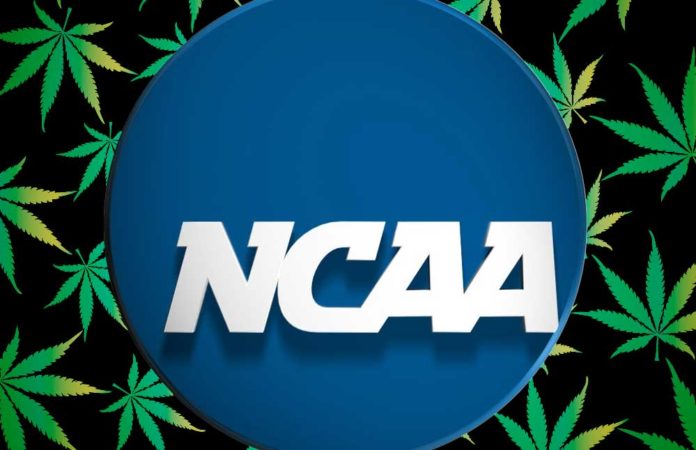Sep 13, 2023A Q&A with Dr. Jeff Konin on the NCAA CSMAS signaling support for removing cannabis from its banned drug list
In mid-June, the NCAA Committee on Competitive Safeguards and Medical Aspects of Sports (CSMAS) signaled its support for removing cannabis from its banned drug list and drug-testing protocols.
Its reasoning stemmed from the December 2022 Summit on Cannabinoids in College Athletics where there was a consensus opinion that cannabis is not a performance-enhancing drug and that a harm-reduction approach is best implemented at the school level.
Additional rationale included: focusing on testing for substances that provide an unfair advantage; taking a similar approach with cannabis as the NCAA does with alcohol; and educating student-athletes on the health threats that are posed.
To get some further insight on the matter of marijuana used at the collegiate level by athletes, Training & Conditioning spoke to Jeff Konin, Ph.D., ATC, PT, FACSM, FNATA, clinical professor and Director of the Doctor of Athletic Training at Florida International University. Konin is also the director of the global initiative for cannabinoid research and education.
Training & Conditioning: What is your initial reaction to the NCAA CSMAS showing support for removing cannabis from the NCAA’s banned drug list and testing protocols?
 Jeff Konin: I was pleased to see the recommendation from the NCAA Committee on Competitive Safeguards and Medical Aspects of Sports. I view the role of the NCAA with respect to banned substances primarily to assure fair play absent performance-enhancing measures that athletes might use to create unfair competitive advantages. We have known for a very long time that the research to date has been clear in that cannabis in all of its forms is not a performance-enhancing drug/plant.
Jeff Konin: I was pleased to see the recommendation from the NCAA Committee on Competitive Safeguards and Medical Aspects of Sports. I view the role of the NCAA with respect to banned substances primarily to assure fair play absent performance-enhancing measures that athletes might use to create unfair competitive advantages. We have known for a very long time that the research to date has been clear in that cannabis in all of its forms is not a performance-enhancing drug/plant.
We have followed NCAA drug testing policies for decades now. Despite past measures, the process as we know it has not served as the deterrent we all wished it would have with respect to athletes refraining from marijuana use. In 2023, society, and in particular the United States, has taken on a more acceptable perception toward marijuana use.
This is also a step in the right direction as the NCAA’s historical response to positive drug tests has been punitive in nature. While providing some educational resources about marijuana, in reality, it has been the athlete’s institution that was left to manage the circumstances and provide the necessary guidance for any athlete testing positive. A successful intervention for excessive cannabis use must be managed in a way other than simply handing down a penalty.
T&C: In your opinion, is going towards a harm-reduction approach, similar to alcohol, better than the NCAA’s current position?
JK: Yes. Recent studies show that student-athletes these days have approximately a 10% shift both away from drinking alcohol and toward using marijuana. There are many reasons for this. First and foremost, today’s athletes do not want the experience of caloric weight gain and lingering next-day hangovers associated with drinking alcohol. Additionally, the use of various forms of cannabis by way of vaping provides for easy transport and use from one place to another. Hence, the popularity of vaping and other forms of cannabis use has become trendy for all high school and college-aged individuals. Many of these behaviors begin prior to student-athletes coming to college to play sports.
For these reasons, the all-too-common approach of abstinence does not resonate very well. It didn’t do as much with alcohol use or sexual behaviors, and it hasn’t shown to be as effective with marijuana use either.

A “harm-reduction” approach focuses on timely and factual education for student-athletes not just about the risks and side effects of cannabis, but rather an all-encompassing program that also emphasizes the specific impact that dosage, application, timing, and other factors have on one’s specific sport performance. Such an approach should be individually focused to demonstrate to student-athletes how reaction time may be slowed down, memory recall could be impacted, rehabilitation of soft tissue injuries may be delayed, weight room gains may be limited, and classroom performance may result in decreased academic outcomes.
While many of our athletic department leaders, sports medicine professionals, and others may not be in favor of a harm-reduction approach that focuses more on moderation of use, it is quite frankly a more reasonable approach to take given the loosening of policies, availability of cannabis products, and greater acceptance of its use without belief of adverse consequences.
Colleges and Universities have trained professionals who are much better served to provide meaningful education to today’s student-athletes versus tracking who tests positive and who is suspended as a result of a repeated positive test. I do still believe that institutional testing can be very helpful but not for the purpose of “catching” athletes with marijuana in their system. Rather identify marijuana to better educate one-on-one how it is impacting an individual’s identity in their sports performance and other aspects of their life including the classroom and home situation. In many of these cases, it does serve as the impetus for those who can benefit from professional counseling to better cope with their life challenges and potentially offset what is known as cannabis use disorders.
T&C: In your experience, how can cannabis products, like CBD oil/extracts, be useful for athletes from a recovery standpoint? More specifically, how can it positively affect an athlete’s endocannabinoid system?
JK: It is important to understand that one of the primary reasons that cannabis is not seen as a performance-enhancing substance is that the endocannabinoid system (ECS) is designed for balance and equilibrium in the body. Unlike steroids, blood doping, and other performance enhancers, the use of cannabis does not offer anyone with supra or enhanced capabilities to perform in any aspect. The supplementation of cannabis products works best when a person’s own ECS is deficient in how it is working, a condition referred to as “clinical endocannabinoid deficiency. Think of this like the endocrine system, where symptoms of diabetes prevail when insulin is not being produced and/or blood sugars are too high. The proper intervention of diet, exercise, and insulin when needed does not make one perform at a super level, but rather allows one to function in a more equilibrium state absent diabetic-like side effects of fatigue, weaknesses, frequent urination, blurred vision, slow healing open wounds, etc…
To answer the question more specifically about how cannabinoids can be useful for recovery, we should look at their use with greater scrutiny. While some studies do exist that have explored many results of for example CBD use, these studies have heavily focused on pain, anxiety, sleep, and inflammation. Granted, all of these are important components of recovery. Some would argue that the bulk of the studies have poor methodology, low numbers of subjects, were performed on animals, and are not clinically translatable to humans, and a host of other challenges that critics have brought forth.
Whether it is soft tissue massage, dry needling, or simply active exercise, we are essentially striving to remove one’s symptoms that interfere with optimal performance. When you think of it that way if using cannabinoids can serve as an anti-inflammatory, assist with improved sleep, and decrease pain or anxiety, well then yes of course there may be some benefits with recovery.



